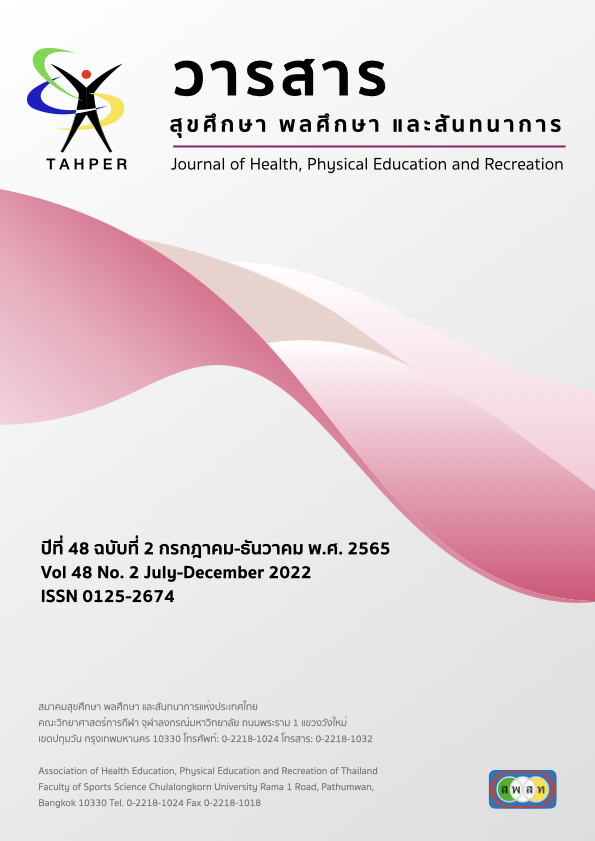ผลของการออกกำลังกายแบบสถานีในรูปแบบห้องเรียนออนไลน์ที่มีต่อสมรรถภาพทางกายที่สัมพันธ์กับสุขภาพของนักเรียนชายวัยรุ่นอายุ 13 – 15 ปี Effect of Online Circuit Training Class on Health – Related Physical Fitness for Adolescence Male Students Aged 13-15 Years
Main Article Content
Abstract
บทคัดย่อ
การวิจัยครั้งนี้มีวัตถุประสงค์เพื่อศึกษาและเปรียบเทียบผลของการออกกำลังกายแบบสถานีในรูปแบบห้องเรียนออนไลน์ที่มีต่อสมรรถภาพทางกายที่สัมพันธ์กับสุขภาพของนักเรียนชายวัยรุ่นอายุ 13 – 15 ปี กลุ่มตัวอย่าง จำนวน 45 คน ได้มาจากการอาสาสมัคร แบ่งกลุ่มตัวอย่างออกเป็น 3 กลุ่ม กลุ่มละ 15 คน กลุ่มออกกำลังกายรูปแบบห้องเรียนออนไลน์ (Online Exercise Class-OEC) กลุ่มออกกำลังกายด้วยตนเองที่บ้าน (At Home Exercise-AHE) และกลุ่มควบคุมที่ไม่ออกกำลังกาย (Non Exercise Control-NEC) ระยะเวลาในการทดลอง 8 สัปดาห์ ๆ ละ 3 วัน เครื่องมือในการวิจัยครั้งนี้ คือ วิดีโอการออกกำลังกายแบบสถานี แบบสะท้อนความคิดเห็นต่อการออกกำลังกายออนไลน์ และแบบทดสอบสมรรถภาพทางกายที่สัมพันธ์กับสุขภาพ และทำการวิเคราะห์ข้อมูลด้วยสถิติบรรยายและทดสอบความแตกต่างก่อนและหลังการทดลองด้วยสถิติ Wilcoxon signed rank test ทดสอบความแตกต่างระหว่างกลุ่มด้วยสถิติ Kruskal-wallis test และทดสอบความแตกต่างรายคู่โดยใช้วิธีของบอนเฟอโรนี (Bonferroni)
(1) ผลการวิจัยหลังการทดลอง พบว่า กลุ่ม OEC มีพัฒนาการดีขึ้นในรายการทดสอบสมรรถภาพทางกายที่สัมพันธ์กับสุขภาพ ได้แก่ ด้านความอดทนของระบบไหลเวียนเลือดและระบบหายใจ ด้านความแข็งแรงและอดทนของกล้ามเนื้อหน้าท้อง และด้านความแข็งแรงและอดทนของกล้ามเนื้อหน้าอกและหัวไหล่ แตกต่างกันอย่างมีนัยสำคัญที่ระดับ .05 กลุ่ม AHE พบว่า สมรรถภาพทางกายที่สัมพันธ์กับสุขภาพทุกรายการทดสอบ พบว่า ไม่แตกต่างกัน และกลุ่ม NEC พบว่า มีพัฒนาการที่ลดลงในรายการทดสอบสมรรถภาพทางกายที่สัมพันธ์กับสุขภาพ ได้แก่ ด้านองค์ประกอบของร่างกาย ความอดทนของระบบไหลเวียนเลือดและระบบหายใจ และความอ่อนตัว แตกต่างกันอย่างมีนัยสำคัญที่ระดับ .05 (2) ผลการเปรียบเทียบระหว่างกลุ่ม พบว่า ด้านความความอดทนของระบบไหลเวียนเลือดและระบบหายใจ แตกต่างกันอย่างมีนัยสำคัญที่ระดับ .05 โดยการวิเคราะห์รายคู่ระหว่างกลุ่ม พบว่า OEC และ กลุ่ม NEC มีความแตกต่างกันอย่างมีนัยสำคัญที่ระดับ .05 แต่ระหว่างกลุ่ม AHE และกลุ่ม NEC ไม่แตกต่างกัน
คำสำคัญ: การออกกำลังกายแบบสถานี, รูปแบบห้องเรียนออนไลน์, สมรรถภาพทางกายสัมพันธ์กับสุขภาพ
Abstract
This exploratory research is intended to comparative analysis of Online Circuit Training Class on Health - Related to the Physical Fitness for Adolescence, Male Students Aged 13 - 15 Years from 45 volunteers. In terms of context and method, the researcher divided into three categories: Online Exercise Class-(OEC) group, At Home Exercise-(AHE) group, and Non-Exercise Control group–(NEC) group. This research experiments for 3 days a week and in terms of 8 weeks. The tool in this research was online circuit training class video, Reflection form on the online exercise of circuit training program and A health-related physical fitness test. Find the quality of the tool from 5 experts and data were analyzed by statistical Wilcoxon signed-rank test before and after training. Analysis of variance with statistics Kruskal-Wallis test and pair analysis using the Bonferroni method of all three groups.
(1) The results after the experiment were OEC group improved development on health-related physical fitness test: circulatory and respiratory endurance, the strength and endurance of the abdominal muscles, and the strength and endurance of the chest and shoulder muscles was a significant difference at the .05 level. The AHE group was not different on health-related physical fitness test. And NEC group decreased on health-related physical fitness test: body composition, circulatory and respiratory endurance, and flexibility was a significant difference (p≤.05). (2) The results were compared between group were circulatory and respiratory endurance It was found that there was a significant difference at the .05 level. Pair analysis were OEC group and NEC group there was a significant difference at the .05 level, but there was no difference between AHE group and NEC group.
Keywords: Circuit Training, Health – Related Physical Fitness, Online Exercise Class
Article Details

This work is licensed under a Creative Commons Attribution-NonCommercial-NoDerivatives 4.0 International License.
Critical thinking in journals is the right of the author. The Association of Health Education, Physical Education and Recreation of Thailand is not always required, to create diversity in ideas and creativity.
ความคิด ข้อวิพากษ์ในวารสารเป้นสิทธิของผู้เขียน สมาคมสุขศึกษา พลศึกษา และสันทนาการแห่งประเทศไทยไม่จำเป็นต้องเห็นชอบด้วยเสมอไป เพื่อให้เกิดความหลากหลายในความคิดและความสร้างสรรค์


